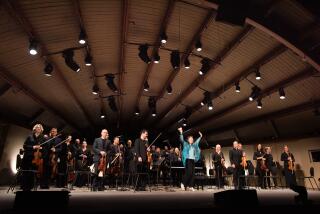MUSIC REVIEW : Camerata Takes a Safe, Sunday Drive
- Share via
NEWPORT BEACH — With the sun streaming through the windows to the airy inside of St. Andrew’s Church, it almost seemed like some Victorian novel in which the atmospheric conditions mirror the emotional states of the protagonists, in this case conductor Ami Porat, the Mozart Camerata and, apparently, the audience.
This season-opener Sunday afternoon was nothing if not pleasant, a friendly revisit to works by Haydn, Mozart and Schubert. Whether Porat and crew plumbed the depths of these pieces is debatable, but perhaps that was not their intention.
The non-threatening nature of the Mozart Camerata’s entire operation--from its safe and sane repertory to its safe and sane music-making--could be be counted as a plus in any organization whose raison d’etre is to bring listeners to classical music. This is not a crime. But neither is this an orchestra that especially delights the musical connoisseur.
The highlight of the afternoon was the reasonably polished, alert and spirited reading of Schubert’s Symphony No. 5 that concluded the concert. Porat (who, according to one of a number of oddly written notes, “is widely known for many original programs delineating multiple symmetries”) enforced brisk tempos and snapped rhythms in the outer movements and found the lyrical warmth of the Andante through an expressive use of dynamics and sculpted phrasings.
Mozart’s Piano Concerto in B-flat, K. 450, filled the second spot on the program; Nadia Nechama Weintraub was soloist. The young (26) musician brought a suitably forthright manner to the display elements of the score but proved indifferent during its more poetic moments. Perhaps the bright and blunt piano (or so it seemed, from upstairs) had something to do with it. Perhaps, too, the orchestral accompaniment, which could be overwhelming at times, played a part. A Chopin Waltz, Opus 69, No. 1, in which Weintraub showed a sensitive touch, was her encore.
The concert opened innocuously with Haydn’s “L’Infidelta Delusa” Overture--Haydn’s opera overtures, for formal and dramatic reasons, don’t really fit the bill as curtain raisers to modern symphonic concerts--and ended, in an encore, with Porat’s own sugary arrangement for strings of Debussy’s “Clair de lune.”
More to Read
The biggest entertainment stories
Get our big stories about Hollywood, film, television, music, arts, culture and more right in your inbox as soon as they publish.
You may occasionally receive promotional content from the Los Angeles Times.










